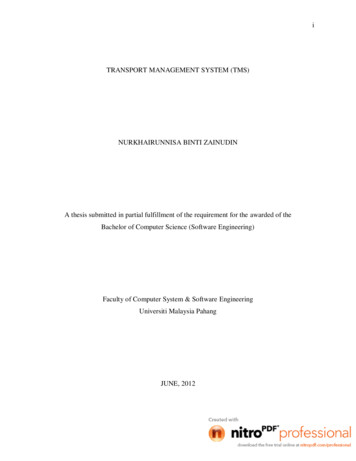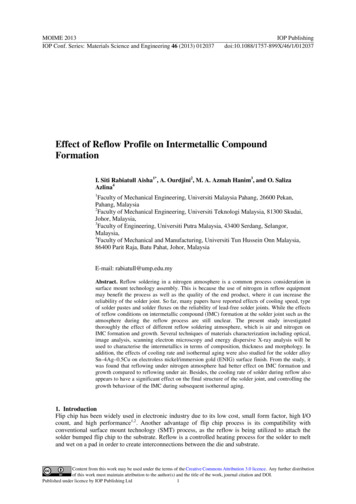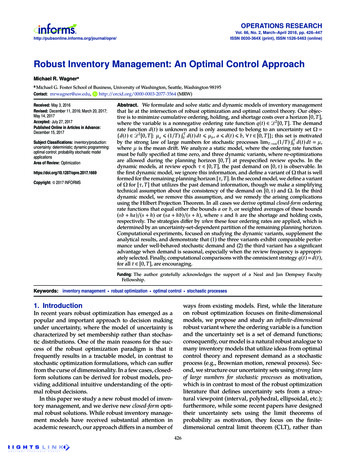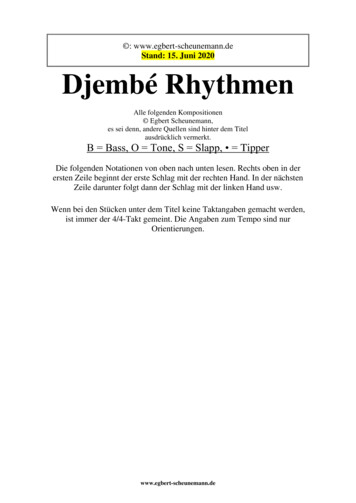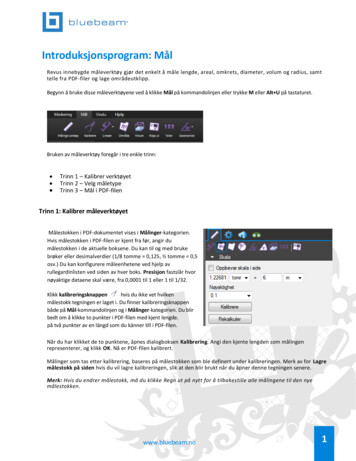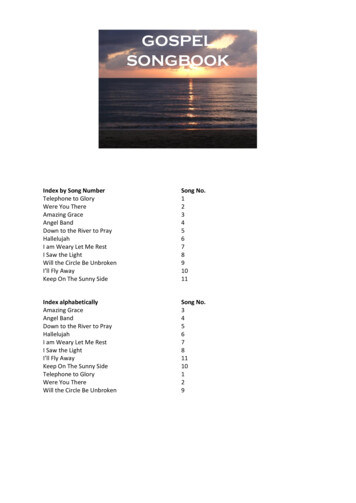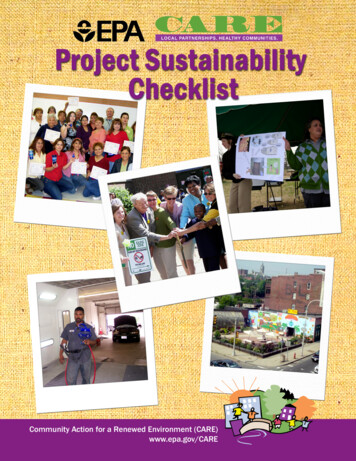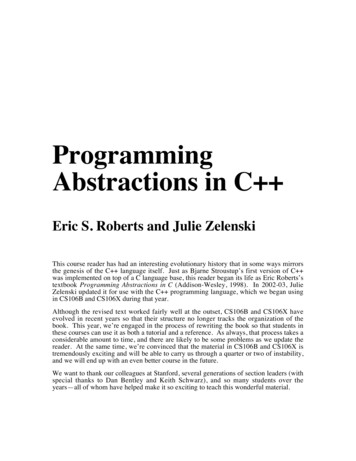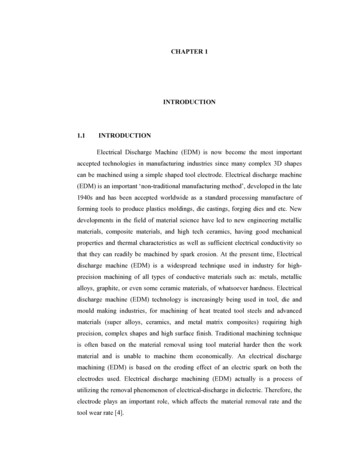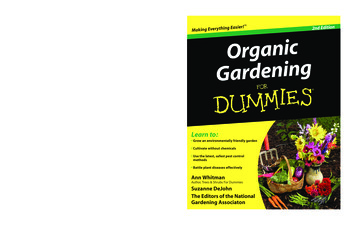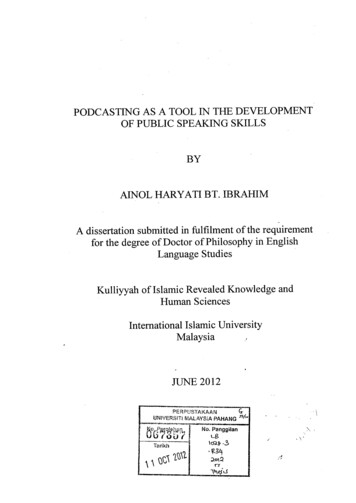
Transcription
PODCASTING AS A TOOL IN THE DEVELOPMENTOF PUBLIC SPEAKING SKILLSmtA1NOL HARYATI BT. IBRAHIMA dissertation submitted in fulfilment of the requirementfor the degree of Doctor of Philosophy in EnglishLanguage StudiesKulliyyah of Islamic Revealed Knowledge andHuman SciencesInternational Islamic UniversityMalaysiaJUNE 2012PEFPUS1AKAANUNVERST MAL.AYS;A PAHANG 2-\c3/
ABSTRACTThis study employed the quasi-experimental, pretest-posttest nonequivalent controlgroup design to investigate the effects of podcasting in reducing anxiety andimproving public speaking skills of ESL learners. Eighty-two students were involvedin the study. They were enrolled in the fifth semester of the Bachelor in CivilEngineering program at Universiti Malaysia Pahang. This sample was divided intothree groups. Two groups were subjected to experimental treatment, and one groupwas assigned as the control group. The Personal Report of Public Speaking Anxiety(PRPSA) was administered as the pre-test and post-test to measure the students' levelof anxiety pertaining to public speaking. The Competent Speaker Speech EvaluationForm (CSSEF) was used as an instrument to measure the students' public speakingperformance at pre-test and post-test. Students' attitude and perceptions on the use ofpodcasting in the public speaking class were explored using a questionnaire survey,and augmented with observations, group interviews and examination of the entriesmade in their respective websites. The overall PRPSA scores revealed that thestudents in all three groups demonstrated a significant reduction in their anxiety level,from pre-test to post-test. Pairwise comparisons between groups revealed that therewas no significant difference between the groups. Similar results were obtained withthe CSSEF, where the students in all three groups made significant improvements intheir public speaking performance. Again, pairwise comparisons between groupsrevealed that there was no significant difference between the groups. However, atpost-test, the experimental group demonstrated a negative correlation between speechperformance and speech anxiety, where students' speech performance improved astheir level of anxiety decreased. A similar relationship between the two variables wasnot evident in the control group. Further investigations revealed that although thestudents in the experimental groups agreed that podcasting should be incorporated infuture public speaking classes, they faced technical-related difficulties such asinconsistent speed and intermittent access to the Internet during the study, thus the"anytime, anywhere" maxim for podcasting was not applicable in this situation.EU
saLli.jcL Li :r JWLLiL3jLr3k CL&J,L''3 :pLzc4'TJLJSLii 433JLUJ'LYL:L)Y.;ui O L4J( i.I(.cJSj.r4J .LJ'(yLL(L)(J3j44U2JLjL3(j(jL:,WiLaji LSJJ.Ly33LL14Ul ôiA-'L9YLY )3jCLJ? J-3k!iLL3kI L4'U2j,U.0i}ULS3j--4(JCL.thUth j4t'jccAJJ-U 3j . L J LJ} yj73L5c&Li -cj--'-3ccJ 3JILL7ai:icIJttYj-3 3j,iLjiLJJS 3 ctçU
APPROVAL PAGEThe thesis of Ainol Haryati bt. Ibrahim has been approved by the following:Nuraihan Mat DaudSupervisorZahariah PilusInternal ExaminerKazunori NozawaExternal ExaminerTameem UshamaChairpersonlv
TABLE OF CONTENTSAbstract.iiAbstractin Arabic .jjjApprovalPage .ivDeclarationPage .vCopyrightPage .viAcknowledgements.viiListof Tables .xiiListof Figures .xivCHAPTER 1: INTRODUCTION .1 .0 Introduction .1.1 The ESL Learner and Public Speaking .1.2 Competence in Public Speaking .1.3 Podcasting in Public Speaking .1.4 Statement of the Problem .1.5 Objectives of Study .1.6 Research Questions .1 .7 Methodology.1.8 Background to the Study .1.8.1 Regulating Bodies in Malaysian Higher Education .1.8.2 The Language and Communication Curriculum at UMP .1.8.3 Facilities at UMP.1.8.4 Facilities for Language Teaching at UMP.1 .8.5 Reasons for Choosing UMP .1.9 Significance of the Study .i.I0 Scope of the Study .1.11 Limitations of the Study .1 .12 Operational Definitions .1.13 Organization of Chapters .12356778910111314151516161718CHAPTER TWO: REVIEW OF LITERATURE .192.0 Introduction .192.1 Factors Influencing Speaking Skills in ESL .192. 1.1 Anxiety in the ESL Speaking Classroom .202.2.1.1 Overcoming Speaking Anxiety in the ESL Classroom. 222.2 An Overview of Public Speaking .252.2.1 Competence in Public Speaking .262.2.1.1 Chooses and Narrows a Topic Appropriately for theAudience and the Occasion .272.2.1.2 Communicates the Specific Purpose .272.2.1.3 Provides Supporting Material .282.2.1.4 Uses an Approriate Organizational Pattern .282.2.1.5 Uses Appropriate Language .29viii
2.32.42.52.62.2.1.6 Uses Appropriate Vocal Variety .2.2.1.7 Uses Appropriate Pronunciation, Grammar andArticulation.2.2.1.8 Uses Physical Behaviours that Support the VerbalMessage.2.2.2 The Effect of Anxiety on Public Speaking .2.2.3 Public Speaking Anxiety .2.2.3.1 Methods to Overcome Anxiety .2.2.4 Skills Training in Public Speaking .2.2.4.1 Approaches in Skills Training .2.24.2 Practice in Skills Training .Public Speaking and ESL Learners .Asynchronous Computer-Mediated Communication .Podcasting: A Web 2.0 Tool in the ACMC Environment .2.5.1 The Process of Podcasting .2.5.1.1 Recording aPodcast .2.5.1.2 Publishing a Podcast .2.5.1.3 Accessing a Podcast .2.5.2 Applications for Podcasting in Higher Education .Conclusion .293030323436404143464853555657595966CHAPTER THREE: METHODOLOGY . 673.0 Introduction . 673.1 Research Design . 673. 1.1 Rationale for the Research Design . 683.2 Reliability and Validity . 693.2.1 Reliability of the Present Study . 693.2.1.1 Reliability of Instruments . 693.2.1.2 Inter-rater Reliability . 703.2.2 Validity of the Present Study . 713.3 Settings . 723.3.1 Participants . 723.3.2 Context . 733.4 Internet Tools . 753.4.1 Digital Audio Editor and Recorder - AUDACITY . 763.4.2 Multiply Network Portal . 773.4.3 RSS Reader . 783.5 Data Collection Instruments . 803.5.1 Personal Report of Public Speaking Anxiety (PRPSA) . 803.5.2 The Competent Speaker Speech Evaluation Form (CSSEF) . 803.5.3 Questionnaire Survey . 823.5.4 Data Triangulation . 833.5.4.1 Open-ended Group Interviews . 833.5.4.2 Blog and Comment Sections of the Multiply Sites . 843.5.4.3 Observations . 843.5.4.4 Documentation Analysis . 843.6 Data Collection Procedures . 853.6.1 Pre In-Class Data Collection . 85Ix
3.6.2 In-class Data Collection. 853.6.3 Post In-class Data Collection .923.7 Data Analysis .923.8 Conclusion .92. 94Introduction . 94Internet Access in UMP . 944. 1.1 Access Venue for Multiply.com . 96Tests for Assumptions . 100Public Speaking Anxiety . 1014.3.1 Public Speaking Anxiety Within Groups . 1044.3.2 Public Speaking Anxiety Between Groups . 107Public Speaking Performance . 1104.4.1 Public Speaking Performance Within Groups . 1114.4.2 Public Speaking Performance Between Groups . 1164.4.3 Competency in Public Speaking Performance . 1194.4.3.1 Public Speaking Competencies for ExperimentalGroup1 . 1204.4.3.2 Public Speaking Competencies for ExperimentalGroup . 1244.4.3.3 Public Speaking Competencies for Control Group . 1284.4.4 Public Speaking Performance Based on IndividualCompetencies. 1324.4.4.1 Performance in Competency 1 Between Groups .1324.4.4.2 Performance in Competency 2 Between Groups . 1334.4.4.3 Performance in Competency 3 Between Groups . 1354.4.4.4 Performance in Competency 4 Between Groups . 1364.4.4.5 Performance in Competency 5 Between Groups . 1374.4.4.6 Performance in Competency 6 Between Groups . 1384.4.4.7 Performance in Competency 7 Between Groups . 1404.4.4.8 Performance in Competency 8 Between Groups . 142Correlation Between Anxiety and Performance . 143Students' Perception of Podcasting .1444.6.1 Students' Personal Identity on Multiply.com . 1454.6.2 Students' Activities on Multiply.com . 1464.6.3 Recommendations to Use Podcasting for Public Speaking . 152Conclusion . 154CHAPTER FOUR: FINDINGS OF THE STUDY4.04.14.24.34.44.54.64.7CHAPTER FIVE: DISCUSSION OF FINDINGS .1555.0 introduction .1555.1 Public Speaking Anxiety . 1555.2PublicSpeakngrfom. . 1575.3 Correlation Between Anxiety and Performance .1635.4 Students' Perception of Podcasting .1645.5 Conclusion .170
CHAPTER SIX: CONCLUSION & RECOMMENDATIONS . 1716.0Introduci . . 176.1 Public Speaking Anxiety .1716.2 Public Speaking Performance .1726.3 Correlation Between Anxiety and Performance .1736.4 Students' Perception of Podcasting.1736.5 Pedagogical Implications for Teachers and Educators.1756.6 Recommendations for Future Research.1766.7 Conclusion .178BIBLIOGRAPHY . 179APPENDIX A:APPENDIX B:APPENDIX C:APPENDIX D:APPENDIX E:APPENDIX F:APPENDIX G:Permission Letter.Personal Report of Public Speaking Anxiety.The Competent Speaker Speech Evaluation Form.A Questionnaire Survey for Multiply.com .Interview Checklist.UHL 3112 Teaching Plan .Feedback Form.xi198199201202204205210
LIST OF TABLESPage No.Table No.3.1Gender, Age and the Result of the MUET Exam of theParticipants733.2Schedule of Classes for the Three Groups753.3Weekly Schedule for the Public Speaking Module863.4Weekly Activities of the Three Groups914.3.1Scoring for PRPSA1024.3.2Frequency for level of anxiety1034.3.3K-W One-Way ANOVA on Anxiety Level1044.3.4Anxiety Level within Similar Groups1054.3.5Anxiety Level between Groups1084.3.6Anxiety Level between Male and Female Students in theExperimental Groups1094.4.1K-W One-Way ANOVA on Public Speaking Performance1104.4.2Difference in Public Speaking Performance within SimilarGroups1114.4.3Difference in Public Speaking Performance between Groups1174.4.4Public Speaking Performance between Male and FemaleStudents in the Experimental Groupsii 84.4.5Description of each of the competencies1204.4.6Experimental Group 1: Competencies in Public SpeakingPerformance1214.4.7 Experimental Group 2: Competencies in Public SpeakingPerformance1244.4.8 Control Group: Competencies in Public Speaking Performance 129xli
Comparison between Groups for Competency 11334.4.10 Comparison between Groups for Competency 21344.4.11 Comparison between Groups for Competency 31354.4.12 Comparison between Groups for Competency 41364.4.13 Comparison between Groups for Competency51384.4.14 Comparison between Groups for Competency 61394.4.15 Comparison between Groups for Competency 71414.4.16 Comparison between Groups for Competency 81424.4.94.5.1Correlation between Anxiety and Performance in PublicSpeakingxlii144
LIST OF FIGURESPage No.Figure No.3.1Diagram for the Research Design683.2Screenshot of Audacity763.3Registration Page for a Multiply Site783.4The Homepage of a Multiply Website794.1 .1 Network Physical Diagram at UMP during the period of study954.1 .2 Venues for accessing Multiply site974.1 .3Relationship between Gender and Access Venue984.1.4 Number of Hours Spent on Multiply Site994.6.1 Activities on Multiply1474.6.2 Students' recommendation to utilize podcasting for publicspeaking152xiv
CHAPTER ONEINTRODUCTION1.0INTRODUCTIONThis study looks into the effects of podcasting on students' public speaking anxietylevel and their speech performance. The development of a variety of easy-to-useInternet publishing tools, such as podcasting, is recently evident (Richardson, 2009).These tools are changing the way people, including learners at all levels, interact withthe world (Solomon & Schrum, 2007). Learning has become more personal, yet at thesame time more connected to the surroundings, and with more potential for connectedand collaborative activities among learners (Kukulsak-Hulme & Traxler, 2007).Web 2.0 technologies encompass the new and emerging Web-based tools,expanding on the effects of network technology (Musser, 2006). Most of these toolsare free and available to anyone with a browser and Internet connection. Web 2.0applications include blogs, wikis, RSS feeds and podcasts. Of these applications,podcast is one application that incorporates the creation and publication of audio files,and podcasts have evolved into a tool with usages ranging from entertainment toeducation, for public purposes such as disaster preparedness to personal purposes suchas in weight loss programs (Dale & Pymm, 2009; Fernandez, Simo, & SalIan, 2009;Turner-McGrievy, 2009).In education, various studies have been conducted to investigate theeffectiveness of podcasting in disseminating recorded lectures and discussions (Chan,Lee & McLoughlin, 2006; Flanagan & Calandra, 2005; Maag, 2006; Tynan &Colbran, 2006). Overall, the results indicated that participants of the studies reported
favourably on the use of podcasts. Podcasts have also been used for learning andmotivation with at-risk high school students in the United States (Checo, 2007). Theresults of the study revealed that the students in the podcast group made significantimprovements in listening comprehension skills. In language classrooms, podcastshave been used either as a form of input for listening skills, or as output for speakingskills (Anzai, 2007; Fox, 2008). However, research that focuses on the use ofpodcasting in English as a Second Language (ESL) public speaking classroom isscarce. This study investigated the effects of podcasting on ESL students' anxietylevel and speech performance in a public speaking class. Challenges faced by the ESLlearners in acquiring speaking skills, particularly public speaking skills, havecompelled researchers to find ways to assist learners in overcoming these obstacles(Ahlfeldt, 2004; Cantwell, 2005; Dc Grez, Valcke & Roozen, 2009; Rojo-Laurilla,2007; Sun, 2008).1.1THE ESL LEARNER AND PUBLIC SPEAKINGIn most ESL classrooms, the instructors are often faced with the daunting task ofgetting the learners to overcome their shyness to speak in the target language (Nunan,1999). Burns and Joyce (1997) identified three major factors that could contribute tothis, which are cultural factors, linguistic factors, and psychological or affectivefactors. Throughout the years, language practitioners and researchers have focused onanxiety stemming from affective factors, offering a variety of resolutions to theproblem (Brown, 1994; Candlin, 1987; Nunan, 1999).Anxiety, often linked to feelings of uneasiness, frustration, self-doubt,apprehension or worry, affects the ESL learners significantly (Candlin, 1987; Ellis,2003). Three components of language anxiety in a second or foreign language context2
are communication apprehension, fear of negative social evaluation, and test anxiety(Brown, 1994).For the ESL learners, performing a task in front of the class increases theircommunicative stress, and is predicted to lead to a reduction in fluency andcomplexity (Candlin, 1987). Sun (2008) postulated that public speaking anxiety forESL/EFL learners is even worse because the speeches have to be given in a foreignlanguage. Ellis (2003) suggested that ESL learners' problems in production may beeased if they are given time to plan before they begin to speak. Accordingly, Nunan(1999) proposed that when teaching students to make oral presentations or to givespeeches, it is important for the instructor to provide opportunities for them to practicegiving prepared, extended presentations or speeches in class.To facilitate adequate practice opportunities, this study proposes the use ofpodcasting in speech practice, in order to reduce speech anxiety and improve speechperformance.1.2 COMPETENCE IN PUBLIC SPEAKINGPublic speaking is defined as "a sustained formal presentation made by a speaker to anaudience" (Sellnow, 2005: 10). According to Fujishin (2009), it is an activityinvolving mental and physical presentations which are different from socialconversational skills. An effective speaker requires physical coordination, mentalconcentration, content organization and skills practice, and a great deal of experience.One of the most often cited challenges to mastering public speaking skills ispublic speaking anxiety (De Vito, 2009; Dwyer, 2005; Fujishin, 2009; Jaffe, 2004;Morreale et al., 2001; Sellnow, 2005; Sprague & Stuart, 2005; Wood, 2004), alsocommonly referred to as public speaking apprehension. This type of apprehension3
falls under the category of context-based communication apprehension. Pribyl, Keatenand Sakamoto (2001) asserted that public speaking anxiety may result from severalcauses, such as perceived lack of public speaking skills, and emotional predispositionstowards public speaking.Researchers and schoJars have postulated that some of the main methods forreducing public speaking anxiety include systematic desensitization, cognitiverestructuring, and skills training (Dwyer, 2005; Jaffe, 2001; Morreale et al., 2001;Richmond & McCroskey, 1998; Sellnôw, 2005; Sprague & Stuart, 2005). Richmondand McCroskey (1998) suggested that skills training is constructive if the individual'shigh apprehension concerns only one type of communication context, for instance,public speaking, and the said individual lacks skills in that area.A number of studies have been done to investigate the impact of differentapproaches in method of instruction in developing public speaking skills and reducingspeech anxiety (Ahlfeldt, 2004; Cantwell, 2005; De Grez et al., 2009). Nevertheless,regardless of the approach, public speaking scholars agree that practice is essential inreducing speech anxiety and developing public speaking skills (Byers & Weber, 1995;Daly, Vangelisti, Neel, & Cavanaugh, 1989; DeVito, 2009; Fujishin, 2009; O'Hair,Stewart, & Rubenstein, 2001; Pelias, 1989; Smith & Frymier, 2006).Practice enables individuals to identify and address speech-related problems orconcerns prior to delivery (O'Hair et al., 2001). In fact, it is "one of the mostimportant factors in confident speaking for speakers at all levels of experience"(Fujishin, 2009; 25). Nonetheless, experts recommend that in order to improveperformance in public speaking, the practice sessions must be as realistic as possible(Menzel & Carrell, 1994; Sprague & Stuart, 2005). Smith and Frymier (2006)emphasised that since realistic practice develops skills, practicing before an audience,4
which is relatively realistic practice, seems more effective than practice methodswhich do not involve audience. Not many studies have specifically addressed the issueof providing realistic or authentic practice for ESL learners in a public speaking class.Thus this study explores the effects of podcasting on anxiety and performance, when itis used as a tool to provide learners with opportunities for authentic practice in apublic speaking classroom.1.3PODCASTING IN PUBLIC SPEAKINGPodcasts are digital audio programs that can be subscribed to and downloaded bylisteners via RSS (Really Simple Syndication). RSS feeds enable learning objects suchas podcasts to be transferred to mobile devices like an iPod, or downloaded onto acomputer (Dale & Pymm, 2009). These RSS files are created by content publishers,and then delivered to people who have subscribed to that feed (Kaplan-Leiserson,2004). In other words, RSS technology allows podcast contents to be syndicatedinstantly on the World Wide Web for download and use by anyone who is interestedin it (Farkas, 2006).In education, podcasting has been used primarily for disseminating recordedlectures and discussions (Chan et al., 2006; Dale & Pymm, 2009; Maag, 2006; Tynan& Colbran, 2006). Among American universities that have implemented podcasting atan institutional level are Duke University, University of California at Berkeley,Princeton University and Stanford University (Fernandez et al., 2009).Although most applications of podcasting in educational settings haveinvolved dissemination of recorded lectures and discussions, students could alsocreate audio projects to share with fellow students, and eventually with the instructor.Podcasting could also be an effective tool for practice or rehearsal (Sze, 2006), in the5
public speaking classroom, providing students with the opportunities to review theirspeeches, and also to broadcast their speeches to a broader range of audience. Thus thespeech preparation process becomes more real, in comparison to the process ofpreparing speeches to be delivered in the classroom, with only peers and the instructoras the "audience". In other words, podcasting enables the learners to have realisticpractice sessions, as recommended by the experts (Menzel & Carrell, 1994; Sprague& Stuart, 2005).1.4 STATEMENT OF THE PROBLEMNumerous studies have investigated communication apprehension in general. Specificfocus has been given to public speaking anxiety, and the associated treatment methods(Ayres, Hopf& Will, 2000; Blood, Blood, Tellis & Gabel, 2001; Garcia-Leal, Parente,Del-Ben, Guimaraes, Moreira, Elias & Graeff, 2005; Merritt, Richards & Davis, 2001;Safren, Heimberg, Homer, Juster, Schneir & Liebowitz, 1999; Sawyer & Behnke,2002). Other studies also include apprehension in accounting students (Aly & Islam,2003; Hassall, Joyce, Ottewill, Arquero & Donoso, 2000; Simons, Higgins & Lowe,1995), apprehension among medical students (Lang, Rowand-Morin & Coe, 1998),and a multinational perspective of communication apprehension among salespersons(Pitt, Berthon & Jobson, 2000).The earlier studies mentioned above have mostly focused on the apprehensionlevel, and in some, on ways to reduce it. More recently, however, researchers havestarted to compare different approaches in the method of instruction for a publicspeaking course, and the subsequent'impacts on anxiety level and speech performance(Ahlfeldt, 2004; Cantwell, 2005; De Grez et al., 2009). Nevertheless, little has beendone to study the impact of technological tools in reducing public speaking anxiety
and improving public speaking performance. Rapid technological advancements,particularly the proliferation of information and communication technology (ICT),makes it imperative to examine how a web-based tool, specifically, podcasting, affectsteaching and learning in a public speaking classroom. This study explores students'use of podcasting in speech practice activities, and its subsequent impact on theiranxiety level and speech performance.1.5OBJECTIVES OF THE STUDYIn general, the main objective of this study is to investigate the effects of podcastingon students' anxiety level and speech performance. The specific objectives of thisstudy are to:I. examine the effect(s) of podcasting on speech anxiety;2. investigate the effect(s) of podcasting on speech performance;3. examine any correlation between anxiety and speech performance and4.investigate students' perception of the use of podcasting in teaching publicspeaking skills.1.6RESEARCH QUESTIONSThe study is guided by the following research questions:I. Does podcasting significantly reduce students' public speaking anxiety?2.Does podcasting significantly improve students performance in publicspeaking?3.is there any correlation between public speaking anx
The Personal Report of Public Speaking Anxiety (PRPSA) was administered as the pre-test and post-test to measure the students' level of anxiety pertaining to public speaking. The Competent Speaker Speech Evaluation Form (CSSEF) was used as an instrument
